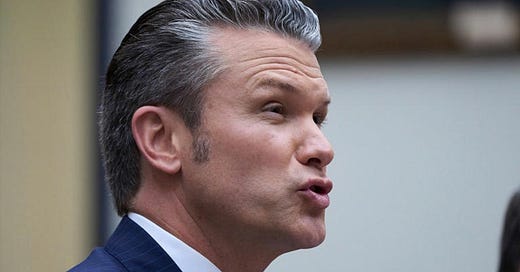Hegseth Emphasizes Restraint but Readiness as Fordo Nuclear Site Struck; Iran’s Uranium Stockpile Remains a Mystery
U.S. Defense Secretary Hegseth warns against escalation as Iran’s nuclear assets vanish into undisclosed locations.
In the wake of the U.S. strike targeting Iran’s Fordo nuclear facility, U.S. Defense Secretary Pete Hegseth delivered a pointed message to both domestic and international audiences: America’s military intervention in Iran is deliberate, limited, and not open-ended, yet the U.S. remains fully prepared to escalate if provoked.
“As the president has directed and made clear, this is most certainly not open-ended,” Hegseth said during a Pentagon briefing.
“But make no mistake — the most powerful military in the world is postured and prepared to defend our people.”
A Calculated Signal
The strike on Fordo, deep inside a mountain and a symbol of Iran’s nuclear ambitions, was met with immediate claims from Iranian officials that their uranium stockpiles and centrifuges had already been removed. Satellite imagery preceding the strike showed tunnel entrances deliberately blocked with dirt and vehicles stationed at the site — clear signs of Iranian anticipation.
Iran’s Atomic Energy Organization spokesperson Behrouz Kamalvandi and former Revolutionary Guard commander Mohsen Rezaei confirmed that nuclear material had been relocated.
Despite these assurances, the fate of Iran’s enriched uranium remains uncertain.
“These enriched stocks have almost certainly been moved to hardened and undisclosed locations, out of the way of potential strikes,” said Darya Dolzikova, a senior research fellow specializing in nonproliferation.
Warning Without Escalation
Secretary Hegseth’s remarks carefully balance deterrence and restraint. While asserting that the U.S. military is “postured and prepared,” he also emphasizes that current actions are “intentionally limited,” signaling a desire to avoid a prolonged conflict.
This messaging aligns with President Biden’s broader strategy to apply pressure on Iran without committing the U.S. to a full-scale war.
Iran’s announcement of a third, undisclosed nuclear enrichment site only adds to the uncertainty and complexity of the crisis. As Iran disperses its nuclear program, traditional methods of oversight and diplomatic leverage become increasingly difficult.
The U.S. response, as articulated by Hegseth, suggests a posture of vigilance and readiness — with the door left open for further strikes, but no intention to become entangled in a long-term conflict.
As tensions simmer, the world watches for signs of Iran’s next moves and the U.S. government’s response. Secretary Hegseth’s firm but measured tone aims to convey both resolve and caution — a delicate balance in one of the most volatile geopolitical flashpoints of our time.




